The Horse Bow – A King’s Weapon
Horse Bow History – What is a “Horse Bow”?
A horse bow is a composite recurve bow used on horseback. The horse bow originated in the Central Asian Steppe and was an essential tool for survival amongst the early pastoralists in this region. The domestication of the horse in Central Asia around 3500 B.C.E. allowed groups of nomadic hunter-gatherers to effectively control large herds and large areas of land. With the additional advent of a sufficient long-range weapon, ancient nomads would dominate the Steppe and cause much trouble for their “civilized” neighbors throughout history.

The early history of these nomads and their composite horse bow is not well recorded, as the people who developed it did not have a written tradition. These early herders and hunter-gathers of the vast grasslands of Eurasia would have come into contact with the early settled civilizations of the Bronze Age (3000 BC – 1200 BC), such as the Egyptians and Chinese. The composite bow was incorporated into the arsenal of these early sedentary people. The Pharaohs of Egypt and Emperors of Ancient Assyria are usually depicted riding into battle with their composite horse bows at full draw. Indeed the earliest depictions of horse archers are from Neo-Assyrian reliefs dated to the 9th century BCE.
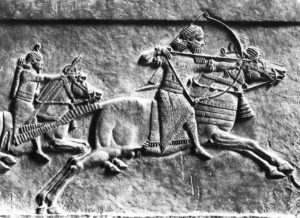
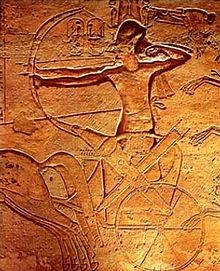
At first, the Assyrians used the composite bow in chariots or on foot. A typical Assyrian battle chariot, much like the Egyptian one, was light and would typically hold the driver and an archer. Eventually, individual riders would wield their bows on horseback. Early Assyrian reliefs depict two riders side by side, one with his bow at full draw, while the other rider beside him holds the reigns and controls the archer’s horse. This is reminiscent of the partnership between driver and archer from past chariot based warfare. The co-driver would eventually be abandoned and individual horse archers would ride without assistance.
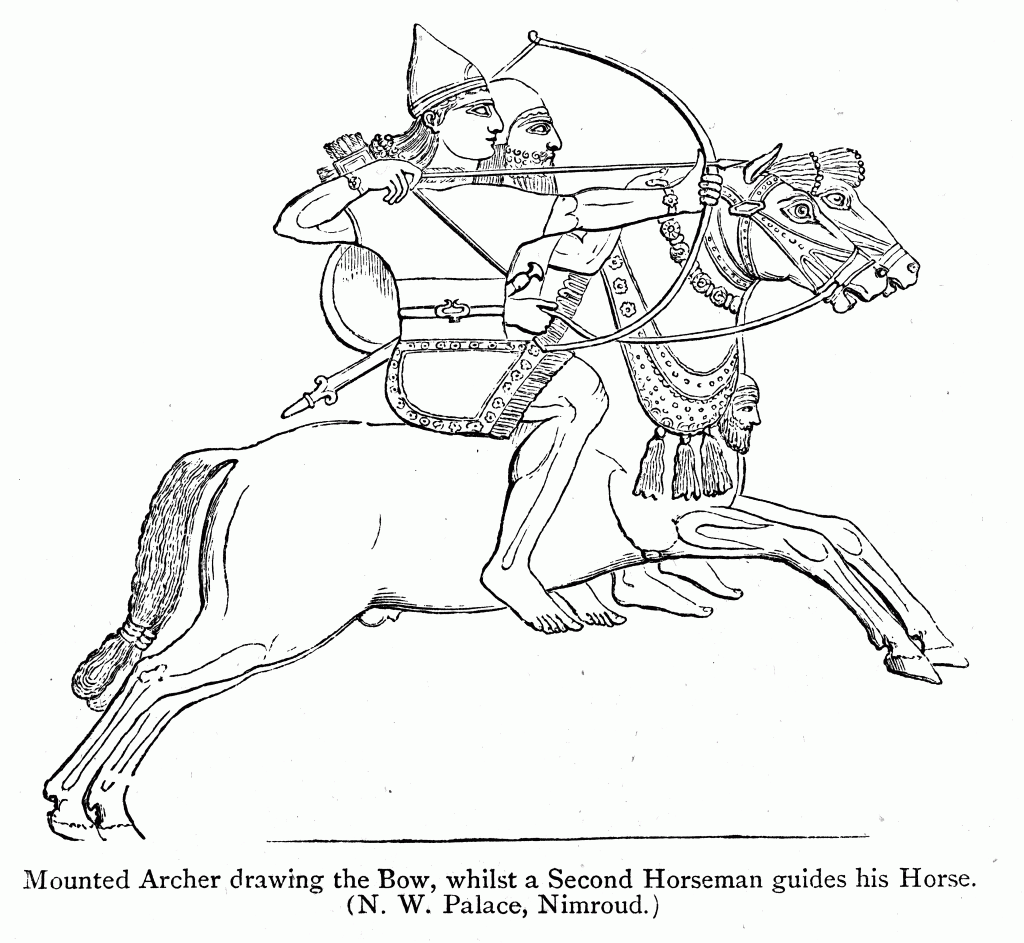
The effectiveness of horse archers is evident in many ancient battles. Two notable examples are the Battle of Carrhae fought in 53 BC between the Romans under the command of Marcus Licinius Crassus and the Parthians under a general by the name of Surena. Crassus came to the Parthian lands (modern-day area contains South-Eastern Turkey, Syria, Iraq, and Western Iran) with an army of seven legions (about 35,000 heavy infantry). Additionally, he had about 4,000 light infantry and 4,000 cavalry. The Armenian king Artavasdes also contributed 6,000 cavalry to help fight their common enemy. The Parthians, on the other hand, had only 9,000 horse archers and about 1,000 cataphracts (heavy cavalry).

The Roman infantry was immobilized by constant arrow fire, and when they tried to engage in close-quarter combat, the Parthians would retreat, all the while firing back into the Roman lines (Parthian shot). When the legions formed into the testudo, interlocking their shields, the Parthian heavy cavalry would charge the line to break up the Roman formation and in the confusion, the horse archers would resume picking off the disoriented Legionnaires. This would be one of the most devastating losses suffered by the Romans at the hands of a primarily horse archer army. An estimated 20,000 Romans died and an additional 10,000 were captured, while the Parthians lost few. Crassus himself lost his life the next day when peace negotiations turned violent.

The other notable ancient battle where pastoralists armed with horse bows had managed to frustrate a super-power was the European Scythian campaign of Darius I (513 BC). The events of the campaign were well documented by the Greek historian Herodotus. Darius was unable to conquer or even directly engage the Scythians as his armies were drawn deep into Scythian territories. Because of their nomadic lifestyle, the Scythians did not have any permanent settlements and so the Persians were unable to entice them into a pitched battle. Eventually, the Persians would suffer losses from sickness and fatigue, forcing Darius to withdraw.
The military effectiveness of mounted archers would continue to be demonstrated many times in the Middle Ages. The swift raids of the Magyars in the 9th and 10th centuries, as well as the devastation brought by the Mongols in the 13th, are all testament to the brutal effectiveness of mounted archers.
Horse Bow Anatomy & Construction
Trees are not very abundant in the interior Steppes of Eurasia, so constructing a bow out of a single piece of wood (self-bow) was not very practical for the early nomads. Bow evolution would take a different path than bows in Northern and Western Europe, where there was ample supply of lumber. Instead of making the bow out of one stave of wood, a composition of materials would be used, and hence the name – composite bow. All traditional horse bows were constructed out of 5 materials. A small wooden core (Maple was preferred amongst many nomads), horn and sinew. These materials are bound together with a natural glue, typically from the swim bladders of fish. Finally, a leather or bark casing would be used to cover the finished product.
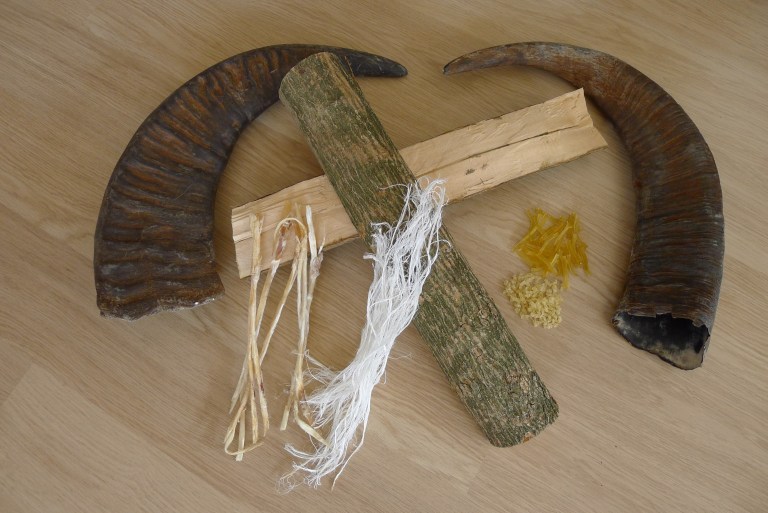
Maple has a fine straight grain which helps prevent the bow from twisting and it bonds well with adhesives. The most widely used horn was that of the water buffalo but horn from a variety of other animals is known. The Magyars and Huns would use horn from the Hungarian grey cattle (Bos taurus). Horn withstands compression and is able to store energy efficiently. Tendons would typically come from spinal tendon “backstrap tendon” of cattle. The tendon is dried and beaten in order to separate it into smaller and smaller fibers, which is combed and readied for application to the bow.

The sections of the wooden core are steam-bent into shape joined together with the help of glue. The geometry of a composite horse bow is such that the unstrung shape is opposite to the bow when it is strung and at full draw. Since horn resists compression, it is placed onto the belly of the bow (side facing archer when drawing bow) and since sinew resists stretching it is clued to the back of the bow. This is the genius of ancient composite bow construction, the layering of these materials with different properties created a bow which can store a lot of energy for its size.

A traditional horse bow is constructed in stages, and the entire process, from procuring materials to the finished product could take a year or more. The first stage in the construction process involves steaming the wooden billets and placing them in a mold which will give the bow an initial rough shape. The newly formed sections of the horse bow are then glued to each other. Once sufficiently dried the bow is sanded and filed further into its final shape. Next, the bowyer uses special scrapers to score the surface of the back of the bow where the horn will be applied. The horn is also heated and bent into shape before being applied to the wooden core. The horn and wood are held together by a helically wound cord. The bow is tied between its knocks in the reflexed position while the glue cures.

The next stage involves placing the horse bow into a “conditioning box” where it will remain at a constant, warm temperature in order to accelerate drying. After sufficient drying, the bow is shaped down further by scraping the horn down to form a smooth union with the wood below. The amount of horn to be removed will influence the final draw weight of the bow.
Next, the bow will receive the sinew. The carefully prepared bundles of sinew are soaked in the glue mixture and evenly applied over the back of the bow. The fibers are made to lay lengthwise across the horse bow. Special combs are used to straighten and align the sinew fibers along the bow. Allowing the sinew to dry and applying additional layers will make the bow stronger and more resilient. Once the final layer is added, the entire bow is tied up in the extreme reflex position and allowed to dry. The drying process can take up to a year or more.
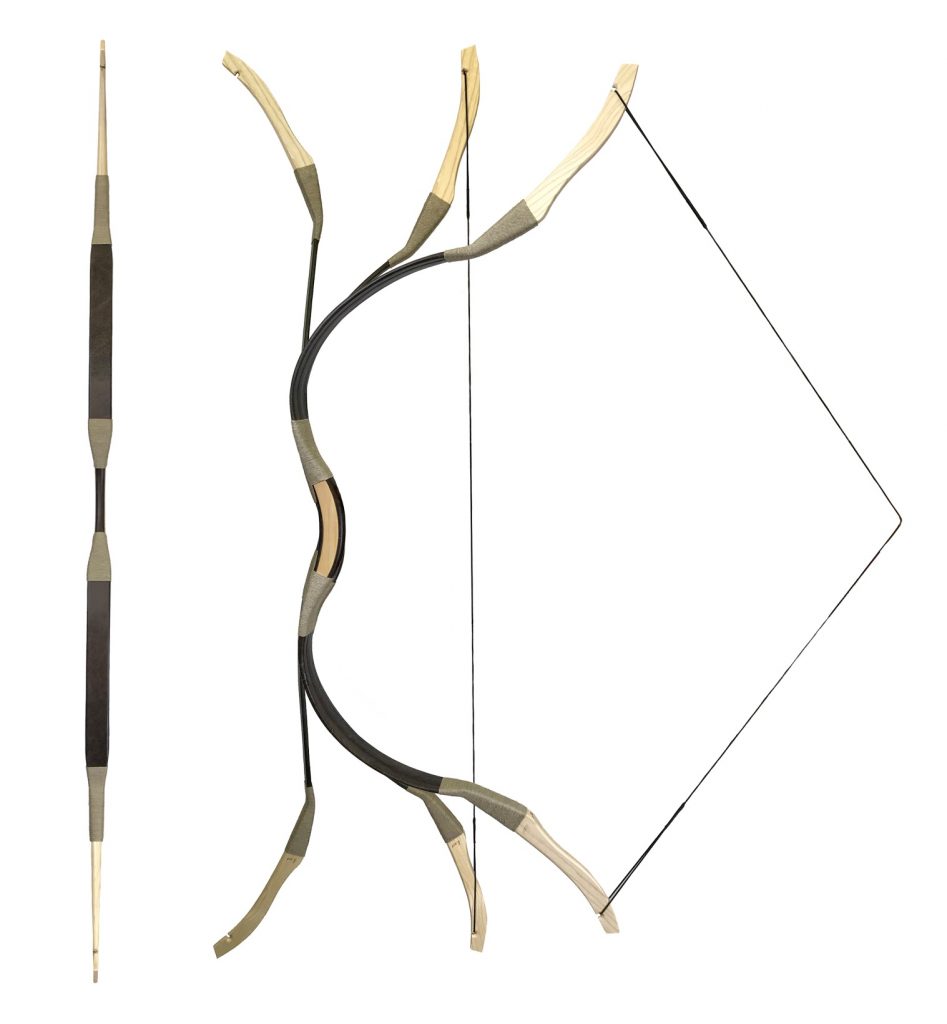
CHECK OUT OUR HORSE BOWS!
Horse bows are also constructed using a composite of modern materials. Most are still built with a wooden or bamboo core, but fiberglass is used in place of sinew and various hard plastics are used instead of horn. A truly traditional horse bow is made with traditional, organic materials.
Horse Bow Use
The draw technique most widely used in ancient times by people using horse bows is the thumb draw. Unlike the Mediterranean which uses the index, middle and ring fingers to pull the string, the string rests only on one digit with a thumb draw, the thumb. On a Western or Mediterranean draw, the arrow is typically placed on the left side of the bow for a right-handed archer, conversely, the arrow is placed on the right side of the bow for a right-handed archer who uses a thumb draw. This technique allows the arrow to be held in place against the bow by the index finger of the draw hand. Stabilizing the arrow in such a way would be of great benefit when the archer is on the back of a galloping horse. Quivers were also typically placed on the right side of a right-handed archer, so reloading arrows would be quicker and easier with a thumb draw, where the arrow rests on the right side of the bow and the same side as the quiver.

The horse archers of the ancient world were a force to be reckoned with. A combination of speed and ranged weaponry would cause great frustration and demoralization for whoever would be so unfortunate to have to fight a predominantly mounted army, firing volley after volley with their efficient horse bows. The mounted nomads were very cunning in the way they waged war, often severely outnumbered, but well trained and practiced mounted archers would devastate much larger armies (Battle of Carrhae, see above).

The Byzantine Emperor Leo the Wise wrote in his military treatise Tactica (c. 895–908) of the Magyars “It is fighting from a distance and laying ambush, surrounding their enemy, feigning retreat, turning back and tearing apart taxises (formations) that are most to their liking”. The infamous technique of shooting backward from a horse at full gallop (Parthian shot) was used by many mounted peoples to trick their adversaries. Their retreats were planned well in advance. The frustration and devastation caused by horse archers did not encourage the historians of their adversaries to portray them in a positive light. As noted by the famed Hungarian horse archer Kassai in his book titled “Horseback Archery”, “After the fall of those proud archers, their enemies became hyenas, and the first thing they did was to rewrite history with poison pens. An unprecedented amount of inauthentic drivel was written about those peoples. Ammianus Marcellinus only knew the Huns by hearsay, never saw a living Hun, yet it was his falsehoods that made it into the histories of the West and became received wisdom to such an extent that it still defines public opinion.”( Pages 14, 15)
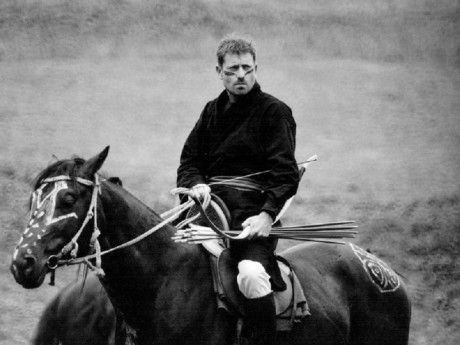
Decline
The horse bow saw it’s decline with the introduction of firearms. However, composite horse bows remained in use alongside firearms well into the 17th century A.D. Eventually, with the invention of carbines, repeating rifles and the maturation of firearm technology, the ways of mounted archery were in steady decline. There has been a recent revival and interest in mounted archery as recreation and a competitive sport.
Revival
Hungary
Because the Magyars who settled in modern Hungary were a mounted people, relying on the bow as their primary weapon for millennia, horse archery is in the blood of the Magyars. After the decline of communism in the 20th century, Hungarians sought to become reacquainted with their traditional roots. Mounted archery as a martial art was very supportive in the rediscovery of Hungarian history and national identity. Lajos Kassai is credited with helping to revive the sport of horseback archery first in Hungary than internationally. Kassai invented the competitive rule system of horse archery in the late 1980s, and started to propagate this new sport. He familiarized himself with Zen-archery in Kamakura, Japan, and travelled to Shao-lin in China to study. See here for a track database: https://www.horsebackarchery.info/coursedatabase. Check out ArcherHistorian.com’s selection of modern Hungarian horse bows here.
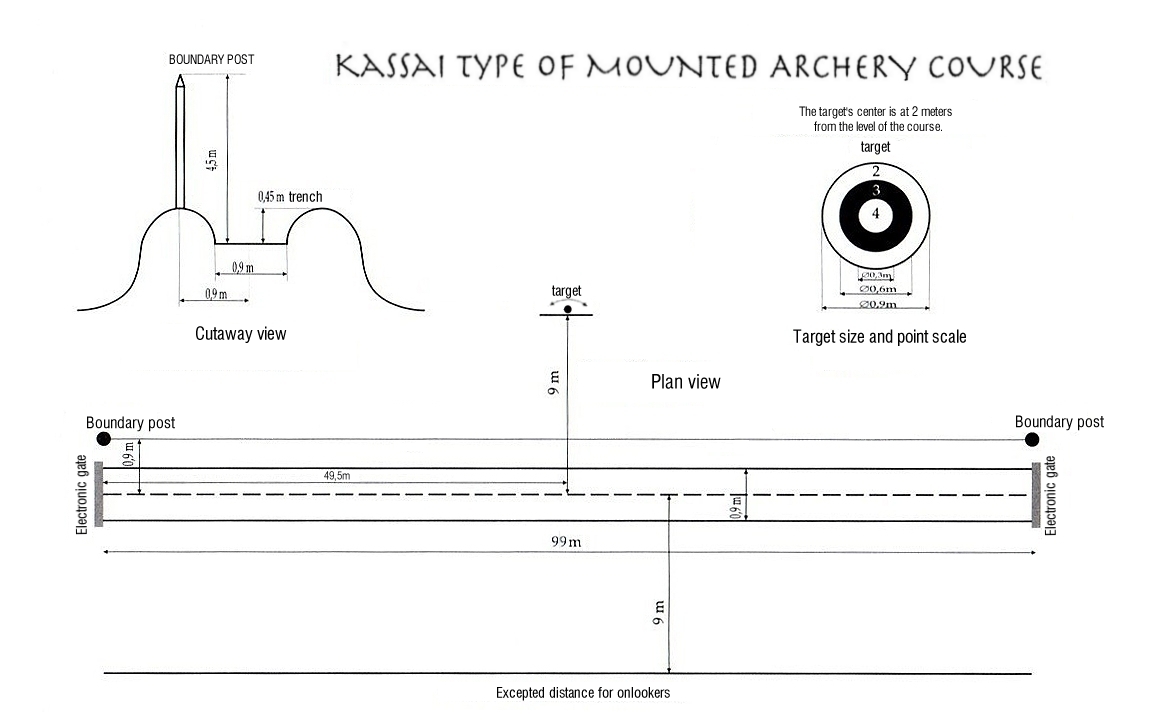
Poland
Poland has been quick to take up the sport at a very high level and are very well represented at the very highest level of the sport. Check out AMM Archery for more on the Polish team. The Polish track is typically much longer (600 meters to 1 KM) than other styles of competitive horseback archery and consists of a combination of many shooting style and arrangements.
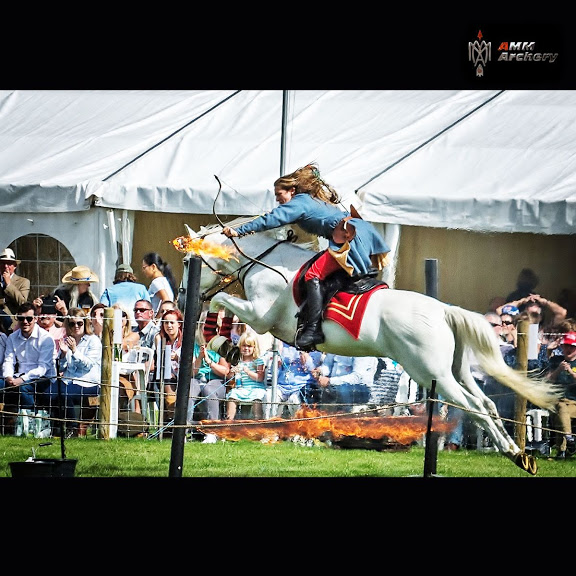
Turkey
There is a strong continuum of archery practiced in Turkey. The ancient nomads of Anatolia relied on their composite horse bows for hunting and warfare. Much later, archery was still a highly regarded skill in the Ottoman empire. Turkey still has a strong archery tradition to this day with tournaments emphasizing flight shooting and the qabaq. In the qabaq style, an object such as a metal plate or ball is placed on top of a mast several meters in the air. The horse archer must ride past the mast and try to hit the object on top. This practice may have arisen from mounted archers shooting up fortified walls.
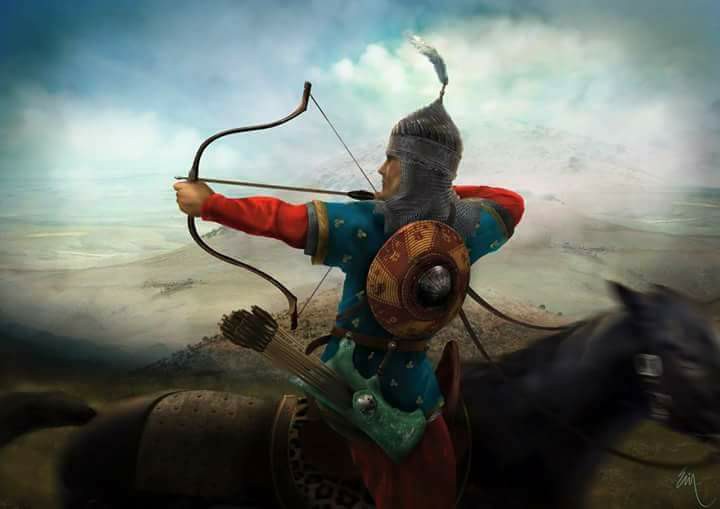
Mongolia
Mongolia has a long tradition with horse bows and mounted archery. Nomadic life on the steppe preconditioned the Mongols for great success in warfare. Ghenghis Khan would not have been able to establish the largest land empire of history without his mounted archers. Over the centuries and with the introduction of firearms, traditional mounted archery had declined on the Mongolian steppe. After Mongolia’s independence in 1921, archery has seen a revival and is displayed at festivals, especially the Nadaam. Check out ArcheryHistorian.com’s Mongol bows here.
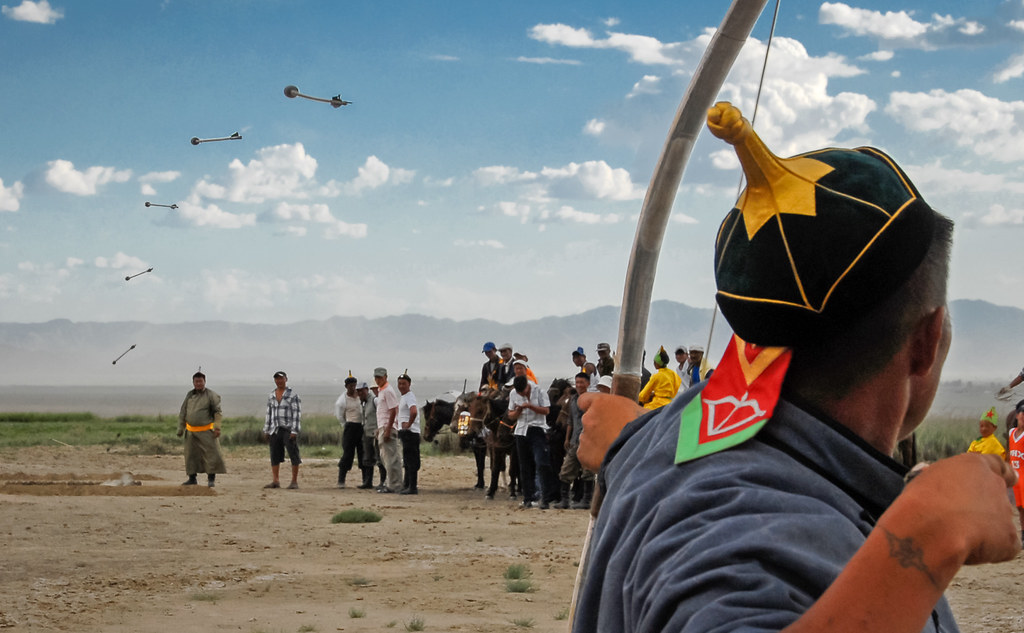
Korea
Korea has a long history with archery, and some of the best professional modern archers are of Korean descent. In 2007 the South Korean government passed a law to help encourage and preserve traditional Korean martial arts, among them, horseback archery. There are several Korean horseback archery tracks each with a different number of targets.
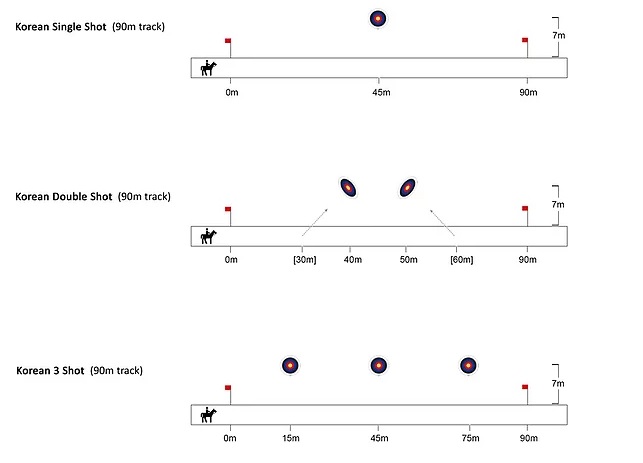
Japan
The Samurai were well-practiced in the art of mounted archery. Eventually in Japan, like in many other parts of the world, archery began its decline with the introduction of firearms by the Portuguese in the 16th century. In recent decades, however the practice of mounted archery has seen a revival as many Japanese seek a connection with their national heritage and traditions. Japanese archery is known as Kyūdō and the mounted version of Japanese archery is know as yabusame. The long, asymmetric traditional Japanese bow known as the yumi is used in both practices.

China
Archery has long been practiced in China and has in recent times been revitalized. Several archery enthusiasts manufacture quality horse bows whose designs are influenced by many Asiatic composite bows throughout history. Two notable Chinese bow manufacturers are Ali Bow and AF Archery.

The West (Western Europe, U.S.A., Australia, Canada, U.K.)
Many horseback archery schools have opened up all over the world. A list of some of the traditional archery associations can be viewed here: https://www.horsebackarchery.info/links.